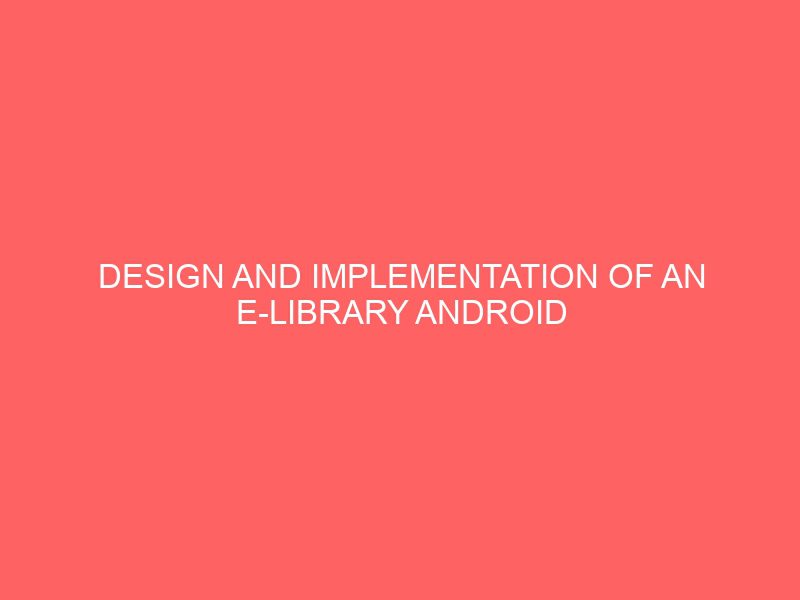Description
Design and implementation of an e-library android app
ABSTRACT
Libraries have been an important part of educational and information sector of any school. The success of any library largely depends on proper management.
Several libraries have suffered failure as a result of inadequate management and incapacitations in handling sensitive information as regards members of the library.
This research therefore, aimed at developing a mobile library app, which will help direct and position library to meets its ever increasing demands.
In the course of the development of this new system, the current system was analytically and critically studied or assessed and thus the identified strengths and weaknesses were highlighted and a new system was designed for the weakness.
The present system was analyzed using a standard procedure recognized worldwide for such purpose and this is called Structured System Analysis and Design Methodology (SSADM). The software was developed using JAVA and Android studio. This language was chosen because of its easy syntax and structure for developing mobile applications.
TABLE OF CONTENT
Title page i
Approval Page ii
Table of content iii
Dedication iv
Acknowledgment v
Abstract vi
CHAPTER ONE
- Introduction
- Background Of The Study
- Statement Of The Problem
- Objective Of The Study
- Scope Of The Study
- Significant Of The Study
- Limitations Of The Study
CHAPTER TWO
2.1 Literature Review
CHAPTER THREE
3.0 Methodology and Analysis of the Existing System
3.1 Sources of Data
- Methods Of Data Collection
- Interview Method
- Observation Method
3.2.3 Record Consultation:
3.3. Organizational Structure
3.4 System Analysis
3.5. Analysis of the Existing System
3.6. Problem of the Existing System
CHAPTER FOUR
4.0 System Design and Implementation
4.1. Analysis of the Proposed System
4.2 File Design Specification
4.3 Output Design
4.4 Input Design
4.5 Justification of Programming Language Used
4.6 Menus and Submenus
4.7 The Main Menu
4.7.1 The Sub Menus
4.8 System Implementation
4.9 Change Over Procedure
4.10 System Specification
CHAPTER FIVE
5.0 Summary, Conclusion and Recommendation
5.1 Summary
5.2. System Maintenance
5.3 Suggested Area for Further Studies
5.4 User’s Manual
References
Appendixes
CHAPTER ONE
1.0 INTRODUCTION
Electronic Library System (ELS) extends and integrate approaches adopted in traditional libraries as well as in distributed information systems, to yield high-end information systems, services and institutions. Here we will explore some of the parts or components of electronic/digital libraries and discuss several of the developments in this emerging field.
Building a comprehensive electronic library system will help users to manage all phases of the information lifecycle. Of particular importance is to simplify the authoring and creation process so that wider population can participate by adding all types of multimedia content directly into digital libraries. Downstream access allows readers to benefit from this type of computer-mediated communication, across time and space. Ultimately, it is believed that knowledge will be shared and then lead to yet another cycle of discovery, authoring and utilization that is facilitated by electronic libraries.
1.1 BACKGROUND OF THE STUDY
Times are fast changing; we now live in a jet age which is mainly characterized by rapid changes in technology, lifestyle and value. This is indeed an age of information explosion.
One of the major inventions that have driven the world to a fast pace of technological advancement is the computer. The computer is primarily an electronic information processor that is rapidly changing the way we acquire, organize, recall, access, analyze, synthesize and apply information. The effectiveness with which the information is generated and communicated determines the rate of progress of a society and the fulfillment of its people. Modern society is information driven and information today is a universal need.
Moreover, computers have affected the ways which people use information. It has changed the rate of work done, the method for accomplishing the work alongside the relationship among the people carrying and using the information. However, computers and libraries are not left out in the utilization of computer to carry out their day-to-day activities especially as it concerns the amount of information generated. Libraries have evolved over the years which gave rise to electronic libraries.
1.2 STATEMENT OF THE PROBLEM
There are numerous problems with the traditional libraries. These in-adequacies are enumerated below.
- The users of the traditional library need to go the library physically which most times could lead to congestion of the library?
- Inability for the library resources to be accessed 24/7.
- The library resources cannot be simultaneously used. It is one at a time.
- Traditional libraries are limited by storage space.
1.3 GENERAL OBJECTIVES OF THE STUDY
The proposed system Electronic/Mobile Library System has it’s general objectives which it is set out to achieve. They are as follows:
- To create variety of access services for searching, browsing and discovering resources from a mobile app.
- To organize and index digital objectives for different purpose which includes cataloging, finding aids and database.
- Reduction of loan and acquisition through the use of digital library.
- Comprehensive storage of large repository of data that can be accessed by authorized users.
- Reduce the cost of maintaining a traditional library.
1.4 SPECIFIC OBJECTIVE OF THE STUDY
The objectives of this proposed system has been narrowed. This is geared towards ensuring that the objectives are achieved. They are as follows:
- Removal of Physical Bounding: Ensure that the users do not always go to the library physically, but can access library resource once he/she is connected to the server.
- Round the Clock Availability: To enable users to be able to gain access 24/7 to the information.
- Information Retrieval: To make it easy and convenient for the user to use any search term (Title OR Authors name) to search the entire collection, thus providing user-friendly interfaces, and giving clickable access to it’s resource.
- Preservation and Conservation: Provide access to materials that would otherwise fall to degradation from repeated use.
- Multiple Access: Ensure that the same resources can be used simultaneously by a number of persons.
- Space: Able to provide storage for information digitally by using little physical space to contain them.
1.5 SIGNIFICANCE OF THE STUDY
In implementing the objectives of this study, the advantages of a digital library over the traditional library are enormous. Users will be able to access library resource digitally without the inconveniences of users carrying books, journals, magazines etc which could result in rapid wear and tear of this library resource. Besides, it will afford users the opportunity to access digital books simultaneously without waiting for the book to be returned to the library.
The proposed system will provide security to help track library resources through the development of a comprehensive database that will be used to house the library resources. The system will also eliminate some of the routine manual work prevalent in a traditional library.
1.6 SCOPE OF THE STUDY
The findings of this research work for the proposed system (Mobile Library System) were carried out at Federal University of Technology, Owerri (FUTO) in their digital library section. The scope of this study will include the following:
- Information indexing/cataloguing.
- Classification of library resource.
- Searching and retrieval (downloading).
- Registration of books/uploading of digital resources
- Registration of users.
- Database management.
1.7 LIMITATION OF THE STUDY
This proposed system will not take into consideration audio collections. It is mobile based not a stand-alone system with its own user file and login ID and password. Also, time constraint during the time for this project work is short. Financial resources is a limitation encountered in the course of this research work.
1.8 DEFINITION OF RELATED TERMS
Terms associated with this topic are to be defined below.
- Android SDK: The Android SDK (software development kit) is a set of development tools used to develop applications for Android platform.
- Android: Android is a software for mobile phones, tablets and a growing range of devices covering everything from wearable computing to in-car entertainment.
- Android is also a mobile operating system developed by Google. It is used by several smartphones and tablets.
- ADB: ABD stands for Android Debug Bridge, a tool that is used primarily by developers to send commands from a computer to android.
- APK: Android Application Package file used to distribute and install applications.
- Android Manifest: Describes the fundamental characteristics of the application and defines each of its components.
- Debugger: A debugger is a computer program used by programmers to test and debug a target program.
- Java: Java is a programming language that produces software for multiple platforms.
- Digital: Relating to or using signals or information represented by discrete values of a physical quantity.
- Library: A building or room containing collections of books, periodicals and sometimes films and recorded music for people to read, borrow or refer to.
- Digital Library: Is a type of information retrieval system in which collections are stored in digital format.
- Information: This is a collection of facts or data.








Reviews
There are no reviews yet.